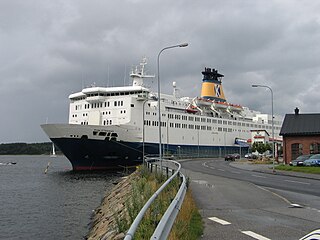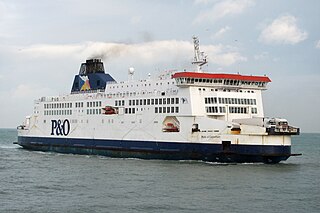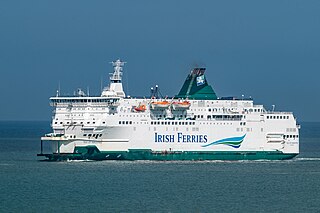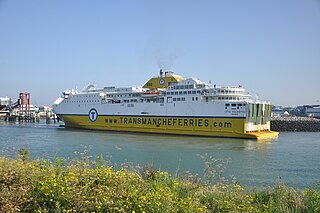History
The idea for a joint service was initially put forward in July 1996 and in October of the same year signed a Memorandum of Understanding for the merger of their ferry interests on the Short Sea routes. The go ahead was given to the merger towards the end of 1997 by UK, French and EU authorities and the new company began on 10 March 1998 with joint livery being officially unveiled the day before. Ownership of the new company was 60/40 in favour of P&O with all shore and sea management performed by P&O. Voting rights between the two companies were 50/50.
Both P&O and Stena also put various building assets into the merger. An example of which was P&O Stena Line's "Central Preparation" kitchens in the western docks, and their training centre (both ex-British Rail buildings). Channel House, P&O's Dover headquarters were leased from P&O Corporate in London to P&O Stena Line.
The Newhaven-Dieppe service was closed in early 1999. P&O Stena was replaced on the route by Transmanche Ferries and Hoverspeed.
In April 2002, P&O announced its intention to buy out the 40% stake in P&O Stena Line owned by Stena and this was completed by August. P&O Stena Line then became part of P&O Ferries.
Ships
On completion of the merger, P&O European Ferries transferred eight vessels into the newly formed company:
The first five being ROPAX ships sailing Dover to Calais, the last three being dedicated Freight only RORO vessels sailing Dover to Zeebrugge.
Stena Line transferred six vessels into the newly formed company:
The first two vessels were sailing on the Newhaven to Dieppe route, the following three vessels on Dover to Calais, and the fastcraft Lynx III was a multipurpose HSC craft operating primarily from Newhaven, but also capable having done so in the past operating from Dover.
(The name Lynx is rooted in the company's past when operating as Stena Sealink Line – the company's first two HSC Craft were named Stena SeaLynx I and Stena SeaLynx II.)
It was decided due to the freight capacity of the Stena Invicta that she would be unviable in a service that had to cut its tonnage down as part of the merger agreements, so she was laid up in France awaiting charter and never saw active service with P&OSL. There was speculation that she would return to service with the company during the annual drydocking periods to serve as a relief vessel, but this never happened. Stena Antrim was also withdrawn immediately and was laid up until being sold.
Initially, the P&O Stena Line fleet was made up of 12 active vessels, these were:
Multi-purpose vessels
Freight ferries
Fastcraft
While all Dover vessels initially kept their pre-merger names, they were gradually changed during each vessel's annual refit and the P&OSL prefix was adopted in 1999 replacing Pride of and Stena prefixes. As a result, Stena Fantasia and Stena Empereur received new names of P&OSL Canterbury and P&OSL Provence respectively.
At Newhaven the Stena Lynx III was renamed Elite in advance of the merger, Stena Cambria kept its name until the closure of the Newhaven-Dieppe service at the start of 1999. The Elite fastcraft was returned to Stena Line and regained its original name, the Stena Cambria was sold.
It was originally intended that P&OSL Picardy would transfer to POSL's Newhaven-Dieppe route. It was planned that a central loading ramp between the upper and lower vehicle decks would be fabricated and fitted, as Dover vessels operate with two loading ramps, whilst many other ports only operate with one. However, this did not occur and the planned transfer never took place.
The P&OSL Picardy remained on the Dover-Calais route until 2001, and then spent several months laid up in France before being sold to a smaller rival firm operating from Ramsgate, TEF Shipping. Today she is the only one of the original three Spirit Class vessels still sailing in UK waters. The other active sister ship, P&OSL Kent is now sailing for a Greek operator. The third vessel was the ill-fated Herald of Free Enterprise that capsized off the port of Zeebrugge in the late 1980s.
During 1998, P&O Stena chartered Stena Royal for use on the Dover-Zeebrugge freight service. The ship was later renamed and refitted P&OSL Aquitaine.
The fleet remained the same until the purchase of Stena Line's share in the company by P&O in 2002. An announcement was made that the Dover-Zeebrugge service would close but the actual closure occurred under P&O Ferries management in December 2002.
This page is based on this
Wikipedia article Text is available under the
CC BY-SA 4.0 license; additional terms may apply.
Images, videos and audio are available under their respective licenses.

















